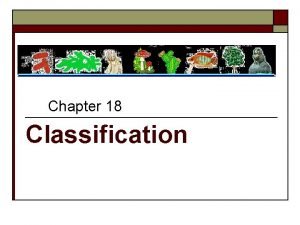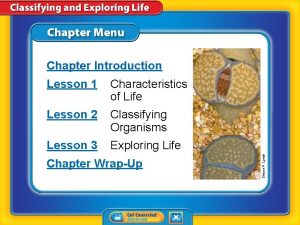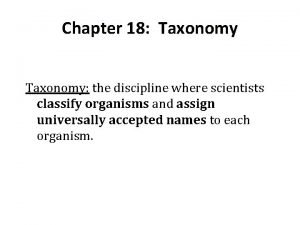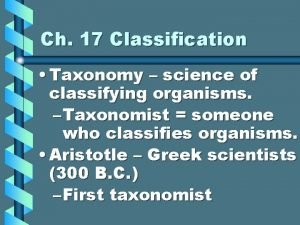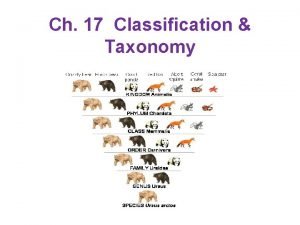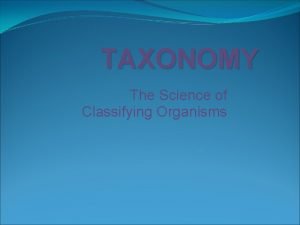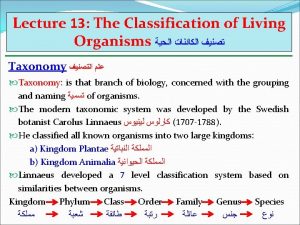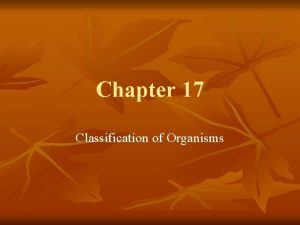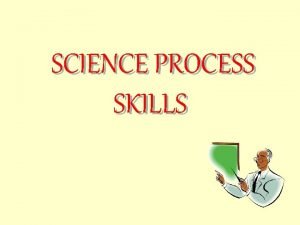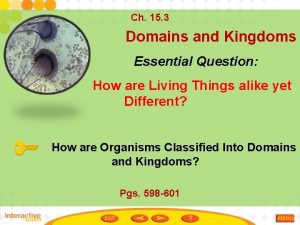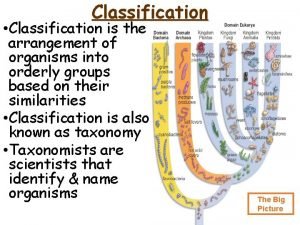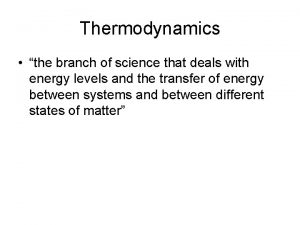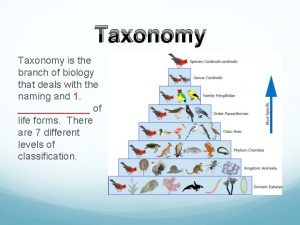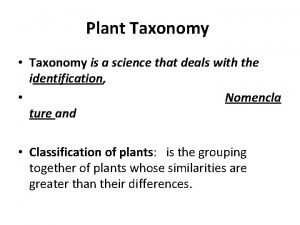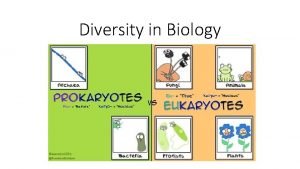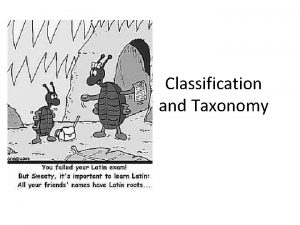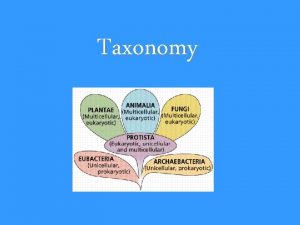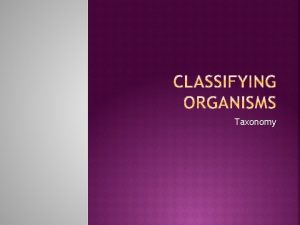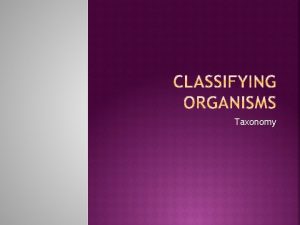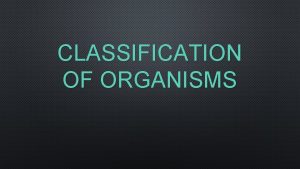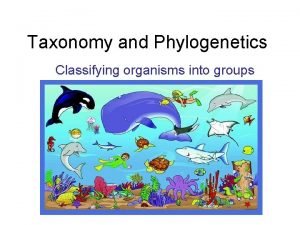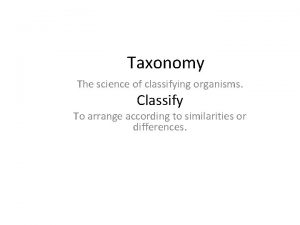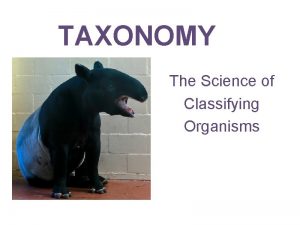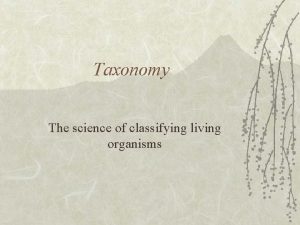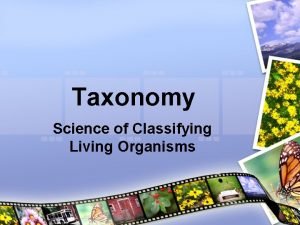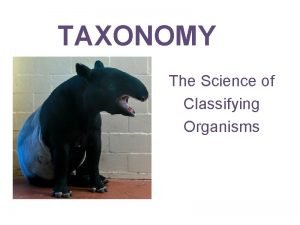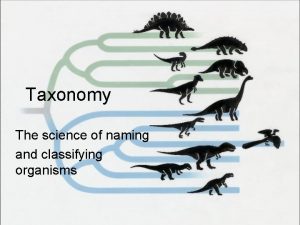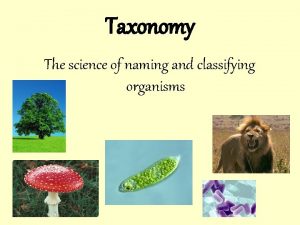Taxonomy Taxonomy the science of classifying organisms into








































- Slides: 40

Taxonomy


• Taxonomy- the science of classifying organisms into groups • Think of the classifications as a hypothesis. As new discoveries are made and new technologies are developed, sometimes the classifications change

At least 95% of the more than 1, 367, 000 species of animals are invertebrates.

Carolus Linnaeus • Swedish naturalist who laid the foundation for our modern classification system in the mid-1700 s including the use of binomial nomenclature

Linnaeus developed the scientific naming system still used today. • Taxonomy is the science of naming and classifying organisms. • A taxon is a group of organisms in a classification system. White oak: Quercus alba

Binomial nomenclature is a two-part scientific naming system. – uses Latin words – scientific names always written in italics – two parts are the genus name and species descriptor

Why Latin? • Latin is a dead language (it isn’t spoken natively anymore), so it isn’t changing • Most scholars at the time new Latin • Latin is a very descriptive language

• A genus includes one or more physically similar species – Species in the same genus are thought to be closely related. – Genus name is always capitalized. • A species descriptor is the second part of a scientific name. – always lowercase – always follows genus name; never written alone

Scientific names help scientists to communicate – Some species have very similar common names. – Some species have many common names.

Linnaeus’ classification system has seven levels. • Each level is included in the level above it. • Levels get increasingly specific from kingdom to species.

The Linnaean classification system has limitations. • Linnaeus taxonomy doesn’t account for molecular evidence. – The technology didn’t exist during Linneaus’ time. – Linnaean system based only on physical similarities.

Vocabulary Which term means one-celled? Many-celled? • multicellular • unicellular Which term means that the organism produces its own food? Consumes food? • autotroph • heterotroph

Vocabulary • Prokaryotic – describes an organism with cells that have a cell membrane but do NOT have a nuclear membrane • Eukaryotic – describes an organism with cells that have a cell membrane and a nuclear membrane

Vocabulary • Autotrophic – makes its own food • Heterotrophic – gets nutrients from the food it consumes

List of the Three Domains and the Six Kingdoms 1. Domain Bacteria • Kingdom Eubacteria 2. Domain Archaea • Kingdom Archaebacteria 3. Domain Eukarya • • Kingdom Protista Kingdom Fungi Kingdom Plantae Kingdom Animalia




http: //www. tellapallet. com/tre e_of_life. htm

Overview of the Three Domains and Six Kingdoms

Kingdom Archaebacteria • Bacteria that live in extreme habitats (extremophiles), such as hot springs, geysers, volcanic hot pools, brine pools, black smokers (hydrothermal vents) • Unicellular • Prokaryotic • Autotrophic or heterotrophic • Cell walls without peptidoglycan

Kingdom Archaebacteria Morning Glory Pool in Yellowstone National Park – note the bright colors from the archaebacteria growing in the extremely hot water.

Kingdom Archaebacteria • Bacillus infernus Some live in temperatures as high as 230° F

Kingdom Archaebacteria • Archaebacteria can live deep in the ocean near hydrothermal vents • There is no light, so they carry out chemosynthesis instead of photosynthesis

Kingdom Eubacteria • Most abundant organisms on the Earth • Bacteria can live in many places on earth, inhabiting a wide variety of habitats, including other organisms • Unicellular • Prokaryotic • Autotrophic or heterotrophic • Thick cells walls with peptidoglycan – a sugar polymer cross-linked by short polypeptides

Kingdom Eubacteria • Bacteria come in different shapes, such as round, spiral and rodshaped.

Kingdom Eubacteria • Bacteria can cause a wide variety of diseases, such as strep throat, food poisoning and the Black Death (bubonic plague of the Middle Ages)


Kingdom Eubacteria • Bacteria also play an important role in decomposition, nitrogen fixation and human digestion (E. coli) Soybean root containing billions of bacteria

Kingdom Eubacteria • Procholorococcus – an autotrophic bacterium

Kingdom Protista • Extremely diverse group • Eukaryotic • Most unicellular, some colonial, some multicellular • Autotrophic and heterotrophic • Cell walls contain pectin (a polysaccharide) but many do not have a cell wall and there a few that have cellulose • Some carry out photosynthesis with chloroplasts

Kingdom Protista Euglena - autotrophic Volvox – a colonial protist A slime mold Amoeba - heterotrophic

Kingdom Fungi • Eukaryotic • Most are multicellular • Heterotrophic, decomposers- feed on dead or decaying organic matter, digest food externally and then absorb the nutrients • Cell walls made of chitin Cordyceps – killer fungi https: //www. youtube. com/watch? v=Xu. Kj. BIBBAL 8

Kingdom Fungi Stilton cheese Bread mold

Kingdom Plantae • • • Eukaryotic Multicellular Autotrophic Cell wall of cellulose; chloroplasts present True tissues

Kingdom Plantae

Kingdom Animalia • • • Eukaryotic Multicellular Heterotrophic No cell walls, no chloroplasts True tissues https: //www. youtube. com/watch? v=n. WSIYl. Iag 6 w Whiptail Scorpion https: //www. youtube. com/watch? v=v. MG-LWy. Nc. As Wasp Larvae

Kingdom Animalia Flatworm Sponge Jellyfish Octopus Coral snake Bear

Some Animal Phylums Porifera- sponges Cnidaria- hydra, jellyfish, corals, sea anemones Platyhelminthes (flatworms)- planarians, flukes, tapeworms Nematoda (roundworms) Annelida (segmented worms)- earthworm Mollusca- bivalves (clams, oysters), gastropods (snails, slugs), cephalopods (squid, octopus) • Echinodermata- starfish, sea urchins, sea cucumbers • Arthropoda- crustacea, spiders, insects • Chordata- fish, amphibians, reptiles, birds, mammals • • •
 Finding order in diversity
Finding order in diversity Taxonomy of cat
Taxonomy of cat The science of naming and classifying organisms
The science of naming and classifying organisms In the hierarchy of classification which grouping
In the hierarchy of classification which grouping Classifying and exploring life
Classifying and exploring life Classifying organisms worksheet
Classifying organisms worksheet Lesson outline classifying organisms
Lesson outline classifying organisms Lesson 2 classifying organisms
Lesson 2 classifying organisms In the discipline of taxonomy what is a domain
In the discipline of taxonomy what is a domain Discipline of classifying and naming organisms
Discipline of classifying and naming organisms Why do scientists classify organisms?
Why do scientists classify organisms? Discipline of classifying and naming organisms
Discipline of classifying and naming organisms Discipline of classifying and naming organisms
Discipline of classifying and naming organisms Competitive interaction
Competitive interaction Single celled and multicellular organisms
Single celled and multicellular organisms Organisms taxonomy
Organisms taxonomy Order of classification of organisms
Order of classification of organisms Crayfish taxonomy
Crayfish taxonomy Organisms taxonomy
Organisms taxonomy Taxonomy in biology
Taxonomy in biology Marzano new taxonomy
Marzano new taxonomy My favourite subject
My favourite subject Manipulative skills in science
Manipulative skills in science Science process skills definition
Science process skills definition How are organisms classified into domains and kingdoms
How are organisms classified into domains and kingdoms Bacteria kingdom monera
Bacteria kingdom monera What are the six kingdoms
What are the six kingdoms The arrangement of organisms into taxa
The arrangement of organisms into taxa Taxonomy is the branch of science that deals with –
Taxonomy is the branch of science that deals with – Are coelenterates warm or cold blooded
Are coelenterates warm or cold blooded Taxonomy is the science that deals with _____.
Taxonomy is the science that deals with _____. Taxonomy is the science that deals with
Taxonomy is the science that deals with Crayfish taxonomy
Crayfish taxonomy Hình ảnh bộ gõ cơ thể búng tay
Hình ảnh bộ gõ cơ thể búng tay Ng-html
Ng-html Bổ thể
Bổ thể Tỉ lệ cơ thể trẻ em
Tỉ lệ cơ thể trẻ em Chó sói
Chó sói Chụp phim tư thế worms-breton
Chụp phim tư thế worms-breton Hát lên người ơi alleluia
Hát lên người ơi alleluia Môn thể thao bắt đầu bằng chữ f
Môn thể thao bắt đầu bằng chữ f
